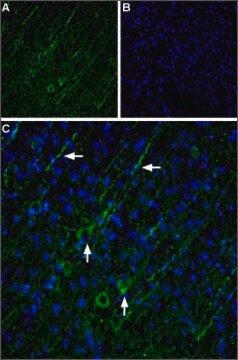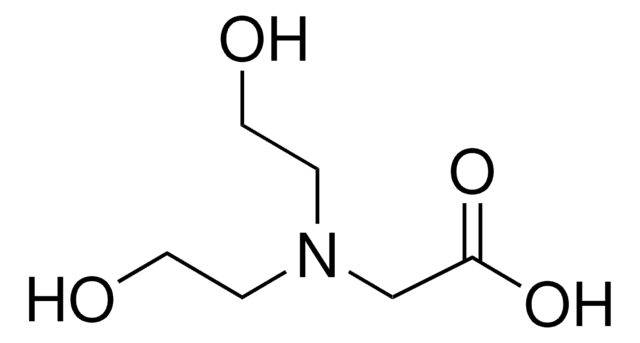T0377
Tricine
≥99% (titration)
Sinónimos:
N-[Tris(hydroxymethyl)methyl]glycine
About This Item
Productos recomendados
Nivel de calidad
Análisis
≥99% (titration)
formulario
crystalline powder
intervalo de pH útil
7.4-8.8
pKa (25 °C)
8.1
mp
187 °C
solubilidad
water: 0.25 g/mL, clear, colorless
aplicaciones
diagnostic assay manufacturing
cadena SMILES
OCC(CO)(CO)NCC(O)=O
InChI
1S/C6H13NO5/c8-2-6(3-9,4-10)7-1-5(11)12/h7-10H,1-4H2,(H,11,12)
Clave InChI
SEQKRHFRPICQDD-UHFFFAOYSA-N
¿Está buscando productos similares? Visita Guía de comparación de productos
Descripción general
Aplicación
- to prevent precipitation of salts during autoclaving of Emiliania huxleyi cultures
- as a component of buffer A for the homogenization of samples like Caenorhabditis elegans, Drosophila, and plants
- as a component of fresh assay buffer to measure serum melatonin by radioimmunoassay
Código de clase de almacenamiento
11 - Combustible Solids
Clase de riesgo para el agua (WGK)
WGK 3
Punto de inflamabilidad (°F)
Not applicable
Punto de inflamabilidad (°C)
Not applicable
Equipo de protección personal
Eyeshields, Gloves, type N95 (US)
Certificados de análisis (COA)
Busque Certificados de análisis (COA) introduciendo el número de lote del producto. Los números de lote se encuentran en la etiqueta del producto después de las palabras «Lot» o «Batch»
¿Ya tiene este producto?
Encuentre la documentación para los productos que ha comprado recientemente en la Biblioteca de documentos.
Los clientes también vieron
Protocolos
This procedure may be used for Collagenase products.
Nuestro equipo de científicos tiene experiencia en todas las áreas de investigación: Ciencias de la vida, Ciencia de los materiales, Síntesis química, Cromatografía, Analítica y muchas otras.
Póngase en contacto con el Servicio técnico






![N-[3-(2-Furyl)acryloyl]-Leu-Gly-Pro-Ala](/deepweb/assets/sigmaaldrich/product/structures/805/876/96b5fb57-71c8-4c6b-b5d2-fafe7374cd85/640/96b5fb57-71c8-4c6b-b5d2-fafe7374cd85.png)

